Chasen and Sensu
In the realm of Chanoyu, there are two objects that are essential, a cha-sen, 茶筅, tea-whisk, and a sen-su, 扇子, fan-of. The tei-shu, 亭主, house-master, must have a cha-sen, 茶筅, tea-whisk, to blend together the cha, 茶, tea, and the yu, 湯, hot water. Both the teishu and the kyaku, 客, guest, and must have a folding sen-su, 扇子, fan-of. The essential utensil for the kyaku is the sensu, and the essential utensil for the teishu is the chasen. The sensu and the chasen are not to be used at the same time. The guest should not use the sensu for cooling oneself. The guest lays the sensu on the floor behind her or him, marking her or his place in the Tearoom. In this manner, the sensu is relatively inactive. The teishu uses the chasen to whisk the tea, so that it is active.
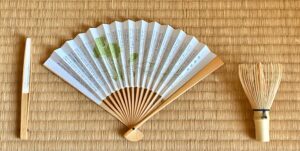
From left: sen-su, 扇子, fan-of; L. 5 sun kane-jaku; sensu; L. 6 sun kane-jaku; cha-sen, 茶筅, tea-whisk; L. 3.75 sun kane-jaku (3 sun kujira-jaku). The sensu has printed on it, ‘Ri-kyū Hyaku–shū’, 利休百首, Rich-quit Hundred-‘poems’.
The appropriate sensu for Chanoyu, regardless of its length, has 13 hone, 骨, bones, ribs, and two end covers. The lengths of the un-papered and papered sections of the ribs of the sensu have a ratio of 8:10. The length of the 3-sun kujira-jaku chasen is divided into two sections that are separated by the kagari-ito, 撚糸, twine-thread, thread wound around the bamboo. The ratio between the two sections is 8:10, which is the same ratio as that of the proportions of the sensu. The standard chasen has a thread that is black, and that keeps the outer tines separate from the inner tines, which is In, 陰, Yin. The standard sensu for Chanoyu usually has a kaname, 要, pivot, that is often black as well as other colors, and keeps the ribs together, which is Yō, 陽, Yang. When the sensu is spread open, it is like the chasen with its spread open tines, they both manifest sue-hiro, 末広, end-wide, which is symbolic of Infinity in Space. Even when closed, the tapered shape of the bamboo sensu manifests suehiro.
The thread is wound around the chasen in a circle, which is an aspect of the negative principle of In. The kaname of the sensu is a straight rod, which is an aspect of the positive principle of Yō. In the Tearoom, the sensu remains closed, which is Yō, whereas the chasen, with its flared tines, remains open, which is In. Although they are not used in the Tearoom, there are sensu that have a loop of thread in the kaname of the sensu to hang from the wrist. This thread may be likened to the thread tassel, musubi-me, 結べ目, of the chasen. Such a behavior is inappropriate in Chanoyu, because the sensu must be held with the right hand, not nonchalantly dangling from one’s wrist. The sensu represents the very soul of its owner, and may be identified with Buddhist scripture.
In cross-section, the bamboo chasen is round and essentially hollow, except for the septum, which are aspects of In, 陰, Yin, receptive. The cross-section of the sensu is rectangular and solid, which are aspects of Yō, 陽, Yang.
At rest, the chasen is upright, Yō, Yang, the sensu at rest is horizontal, In, Yin. The chasen is made of a single piece of bamboo, Yō, the sensu is made of fifteen pieces of bamboo, In.
The Kanji for the numbers 10, 十, and 8, 八, together make the number 18, jū-hachi, 十八, ten-eight. The two Kanji can be written to make the Kanji ki, 木, tree, which is symbolic of ‘life’. The flared tines of the chasen manifest multiple approximations of the kanji hachi, 八. The Kanji, 八, is emblematic of sue-hiro, 末広, ends-wide, which symbolic of Infinity in Space.
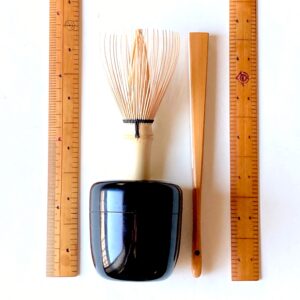
From left: bamboo mono-sashi, 物差, thing-difference, kujira-jaku, 鯨尺, whale-span, and centimeters; bamboo cha-sen, 茶筅, tea-whisk, L. 3 sun kujira-jaku; black-lacquered chū-natsume, 中棗, middle-jujube, H. 1.8 sun kujira-jaku; bamboo and paper sen-su, 扇子, fan-of, L. 6 sun kane-jaku; bamboo mono-sashi, 物差, thing-difference, kane-jaku, 曲尺, bend-span; bamboo.
The length of one of the standard sensu, often used by men in the Tearoom, is 6 sun kane-jaku or 4.8 sun kujira-jaku. Subtracting the chasen length of 3 sun kujira-jaku, leaves 1.8 sun kujira-jaku. This number, 18, is found in many measurements and relationships. In Chanoyu, an essential utensil is the Rikyū-gata chu-natsume, 利休形中棗, Rikyū-style middle-jujube, which has a height and width of 1.8 sun kujira-jaku. This plain, black-lacquered natsume contains either thick tea powder or thin tea powder. The natsume is the possession of the host, and the tea becomes the possession of the guest.
The number 13, the number of ribs of the sensu, is rich in symbolism. 13 represents a center with 12 radiants, hours, months, etc. In Buddhism there are Jū-san Butsu, 十三仏, Ten-three Buddhas, who preside over 13 periods of mourning.
When a guest enters a Tearoom, seki-iri, 席入, seating-entry, through a nijiri-guchi, 躙口, crawl in-opening, the sensu is tucked temporarily in the obi. The guest crouches down on the stone outside of the entrance. The teishu leaves the wooden panel door open somewhat. The guest grasps the edge of the door with the hand nearest the opening, and slides the door halfway open, then grasps the door with the opposite hand and slides the door almost completely open.
The sensu, fan is put on the floor inside of the Tearoom, with both hands placed flat on the floor within. This is to respectfully observe the layout of the room and the utensils. The guest crawls through the nijiri-guchi into the room, and moves the sensu further away on the floor. Once in the room, the guest turns around, faces the door opening, and places the footwear against the outside wall. The guest turns around, picks up the sensu, and proceeds to the tokonoma. The sensu is placed on the floor in front of the knees allowing room for both hands to touch the floor. The sensu acts as a ke-kkai, 結界, unite-worlds; it separates and joins.
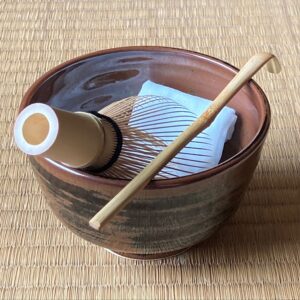
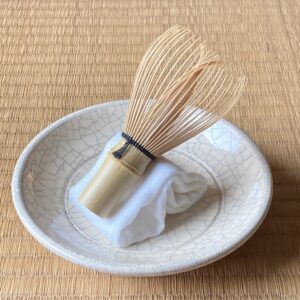
When the teishu enters the Tearoom to present Tea, the chasen is carried into the room supported on a folded chakin held in a chawan, or in a very formal Tea presentation, on a sen-zara, 筅皿, whisk-dish. Sitting outside of the Tearoom and the cha-dō guchi, 茶道口, tea-way opening, the teishu, most often, places the chawan with chakin, chasen, and chashaku, to the side near the door. The teishu opens the door, may give a salutation, and bows together with the guests to begin the Tea presentation. The chawan is carried into the room and placed with other utensils. In one of the most formal Tea presentations, the chasen, on a folded chakin and a small dish, is placed near the door of the chadōguchi at the opening and closing of the door.
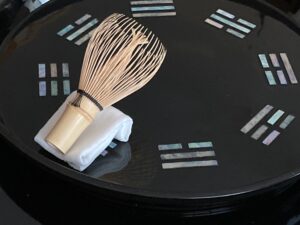
Chasen and chakin displayed on a ha-kke-bon, 八卦盆, eight-sign tray: they are placed on the trigram, ☲, Ri, 離, Fire. The trigram, ☴, Son, 巽, Wind is shown at the right of the trigram Ri. The orientation of the trigrams are to be seen from the center of the tray outward, which is why the trigram for Son in the photograph above is upside down.
In a special Tea presentation, the chasen, chakin, and chashaku are displayed, together with other utensils, on the ha-kke-bon, 八卦盆, eight-sign tray. The tray has designs of eight 3-line divination signs, ‘trigrams’, of the I Ching, Eki-kyō, 易経, Change-sutra. The chasen on top of the folded chakin are placed on the front of the tray on the trigram, ☲, Ri, 離, Separation, which is symbolic of Fire. The trigram Ri is also identified with the south.
The chashaku is placed on the trigram, ☴, Son, 巽, Southeast (Chinese – Obedient), which is symbolic of Wind. It is located on the near right quadrant of the tray, which is identified with the southeast. The ideal nijiri-guchi is located in the southeast direction of the Tearoom, and the southeast is the source of the ‘good wind’. The sensu of the guest is identified with Wind because a fan can create wind. The Kanji for Wind, Son, 巽, is composed of two Kanji, onore, 己, self, and tomo, 共, together. One of the deeper reasons for participating in Chanoyu is to unite the two aspects of oneself: the body and mind – niku-tai, 肉体, flesh-body and sei-shin, 精神, mind-spirit.
The chashaku, handled by the teishu, is symbolically identified with Wind, and the sensu, handled by the guest, can physically create wind. Wind is one of the Go-rin, 五輪, Five-rings, the five principles of Earth, Water, Fire, Wind, and the Void. According to Taoism, Wind is differentiated In and Yō, which is symbolized by a bowl. A bowl can both be full or empty. The nature of wind is movement, like the chasen whisking tea, which is Yō, Yang, whereas the sensu that can create wind but does not, which is In, Yin.
During the preparation of tea, the teishu handles the chasen extensively, whereas the guest handles the sensu when entering and greeting the teishu, and places it on the floor behind the feet, often near the wall, to indicate where he or she is seated. The teishu leaves her or his sensu in the preparation room, mizu-ya, 水屋, water-house, and begins to use the fukusa, and tucks into the obi, which is where the sensu is ordinarily kept when not in use.
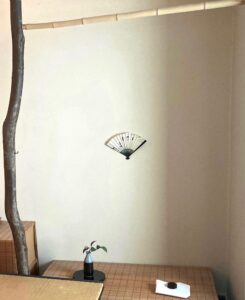
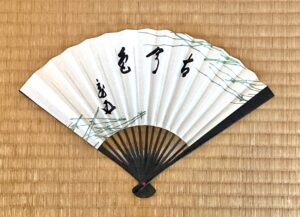
(a) Tokonoma with sen-su, 扇子, fan-of, hanging on the wall, with hana-ire, 花入, flower-receptacle, on a round board, and a kō-gō, 香合, incense gather, on a pack of kami kama-shiki, 紙釜敷, paper kettle-spread.
(b) Sen-su, 扇子, fan-of, with calligraphy, ‘Ko-kon-shiki’, 古今色, Past-present-color, written and signed by Sen Hō-un-sai, 鵬雲斎, ‘Phoenix’-cloud-abstain, XV Iemoto, Urasenke, with design of fallen matsu-ba, 松葉, pine-leaves. The characters are part of a familiar Zen expression, ‘Matsu ni ko kon iro nashi’, 松無古今色, Pine no past present color.
In the course of a Chaji, the sensu of the teishu is rarely seen in the Tearoom. However, a sensu may be displayed in the tokonoma of the Tearoom or the machi-ai, 待合, wait-gather, where the guests assemble before entering the Tearoom. In addition, sen-men, 扇面, fan-face, the paper separated from frame of a sensu, may be mounted as a kakejiku, 掛軸, hang-scroll, and displayed.
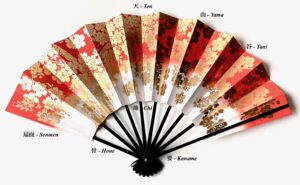
Sen-su, 扇子, fan-of, with ten black lacquered bamboo hone, 骨, bones, heavy paper with a printed design in red and gold of sakura, 桜, cherry. Labeled clockwise from top: Ten, 天, Heaven; Yama, 山, Mountain; Tani, 谷, Valley, Kaname, 要, Pivot; Hone, 骨, Bone; Sen-men, 扇面, Fan-face; center – Chi, 地, Earth. L. 9.5 sun kane-jaku. The ‘mountains’ become ‘valleys’ when seen from the opposite side.
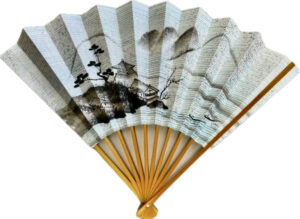
The ‘shira-giku’sensu has 10 bamboo hone, 骨, bones; L one shaku kane-jaku. The length of the paper, sen-men, 扇面, fan-face, is 4.444 to infinity – the length of the revealed bamboo ribs is 5.555 to infinity. The ratio between the two lengths is 8:10. Both 8 and 10 are emblematic of Infinity in Space. The paper sections taper so that the width of each paper section along the outer edge is one sun kane-jaku, and the width of each paper section along the inner edge of the paper is .5 sun kane-jaku.
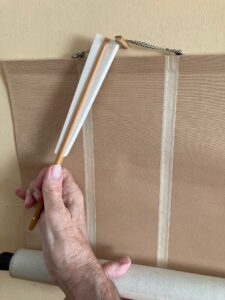
The name of Rikyū’s ‘shiragiku’ sensu comes from the chrysanthemum and other flower white and off-white design on the reverse side. This sensu is used by Urasenke to help hang a kake-jiku, 掛軸, hang-scroll in the tokonoma.
When presenting ‘Jiku kazari’, 軸飾り, Scroll-display, in the presence of guests, the teishu has the sensu slipped in the obi together with the fukusa. When needed, the fan is opened one fold, and the end of one of the ribs supports the scroll’s kake-o, 掛緒, hang-cord, and the scroll is hung on a hook or peg. The sensu is returned to the obi.
After the guests have looked closely at the scroll, the scroll is rolled up and taken down. Another scroll takes its place, as the original scroll is of such importance that it should not be neglected.
There are occasions when a guest may have the opportunity to hang a scroll. At that time, the sensu would be displayed in the tokonoma together with the rolled scroll on a fukusa.
For further study, see also: Chasen, Chasen and Tea, Chasen and the Gorintō, Chasen Suehiro, Chasen Whisk and Thread, Natsume Chasen Chashaku

